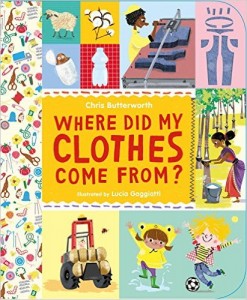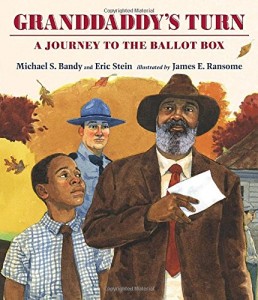Written by Chris Butterworth
Illustrated by Lucia Gaggliotti
Answering the title question, this informative book is surprisingly light and entertaining. The author highlights each piece of clothing most children wear and goes into quite a bit of detail on the origins of the main material used for each. Jeans begin as plants, are harvested by tractors and people, and run through a series of processing steps. Each step is skillfully illustrated, including the maturing bolls and the problems of seed extraction. Readers get a look at spinning machines, looms, cutting presses, the individual jeans pieces, and the seamstresses making the final jeans. The author also talks about flax and hemp. Sweaters are often made of wool, sheared from sheep, washed, dried, spun into yarn, and knitted into garments. Wool also comes from other animals. Silk is especially dear and reserved for party dresses. Manufacturers are experts at raising the moths. Fleece is recycled plastic bottles. Rubber is another plant derivative – with a different process, including tapping, molding, rolling, and pressing. The author gives one last push for recycling at the end.
Second grade readers will learn a lot about the world they live in and practice their literacy skills along the way.
 Title: Where Did My Clothes Come From?
Title: Where Did My Clothes Come From?- Author: Chris Butterworth
- Illustrator: Lucia Gaggliotti
- Published: Candlewick Press, August 2015
- Reviewer: Sue Poduska
- Format: Hardcover, 32 pages
- Grade Level: K to 3
- Genre: Nonfiction, Manufacturing, Recycling
- ISBN: 978-0-7636-7750-3
- Extras: Author’s note, bibliography, index

